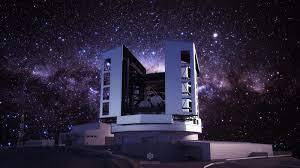28.11.2023

Images of the cosmos from the Hubble Space Telescope and the James Webb Space Telescope have awed the public and astronomers alike. Until the Hubble, breakthroughs in astronomy came from big telescopes on mountain-top observatories—discoveries that include the expansion of the Universe and planets orbiting other stars. A new generation of extremely large ground-based telescopes is under development, which, when paired with space-based observatories, will produce even more remarkable discoveries about our Universe.
In the 1990s, two technological innovations revolutionized ground-based astronomy—segmented mirrors and adaptive optics. These advances made it possible to increase the size of telescope mirrors well beyond 8 m and to undo the blurring effects of Earth’s atmosphere. The extremely large telescopes (ELTs) under construction today, with mirrors that are 25 to 39 m in diameter and adaptive optics, will have 100 times the light-gathering power and 10 times the image quality of the Hubble Space Telescope. These giant telescopes will search for signatures of life on exoplanets, reveal new insights on the nature and origin of black holes, and investigate the deep mysteries of dark matter and dark energy. These technological marvels are also extremely expensive and complex to build and manage.
The European Southern Observatory (ESO)—an organization of 16 member nations—is on track to complete the 39-m European ELT in the Chilean Atacama Desert by decade’s end. The two US projects, the Giant Magellan Telescope (GMT) in Chile (with a 25-m-diameter mirror) and the Thirty Meter Telescope (TMT) planned for Mauna Kea in Hawaii, were initiated almost 25 years ago by private institutions backed by generous philanthropy. Because of their discovery power, the 2020 Decadal Survey of Astronomy and Astrophysics recommended as its highest priority for ground-based astronomy that the United States invest in at least one, preferably two, ELTs. However, the cost of each has now risen to around 3 billion US dollars, and international partners have been added. Both the GMT and TMT have substantial fundraising challenges, and each is hoping to bring the US National Science Foundation (NSF) on as a partner. It is simply not possible for NSF to join both projects at the level needed to make each successful. Instead, NSF should take the lead in planning, building, and operating a single telescope. International partners are a must, and an alliance with ESO might be desirable. NSF knows how to manage such agreements, and international partners will be more comfortable with a government-to-government arrangement.
NSF transitioned the Vera C. Rubin Observatory in Chile from private funding to public funding. A similar shift for an ELT is possible but will be more challenging because international partners are in place and substantial investments have been made. Although NSF has built and operated big facilities that have produced stunning discoveries, such as the Laser Interferometer Gravitational-Wave Observatory, an ELT is beyond even that scale, and so NSF will have to work with Congress and the White House Office of Management and Budget to make the necessary structural changes at the agency to design, build, and operate it.
With its strong connections to the scientific community, NSF can create a fair process to select which project it will move forward with. Because astronomers were hoping for two US ELTs, NSF and leaders in astronomy must explain why a single telescope is the only viable solution. NSF must act soon and not leave GMT and TMT in their current state of limbo. Both projects have made big investments to make the dream of a US ELT a reality, and each urgently needs to plan for its future, with or without NSF.
For 100 years, big telescopes led by private institutions and funded by philanthropy made the US a world leader in astronomy. The cost and complexity of these ELTs have broken that model. Philanthropy is still essential to US astronomy because its nimbleness allows for more risk taking and early investment, as occurred with these big telescopes. Hopefully, philanthropy will continue to do so in the future. Building these amazing windows to our vast Universe is difficult and expensive. But it is worth the effort. These giant telescopes will help us to better understand our place in the Universe and will again demonstrate what humankind can do when we work together to pursue lofty and ambitious goals.
Quelle: AAAS
600 Views
